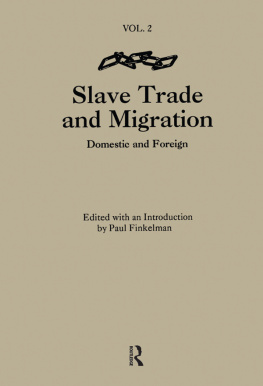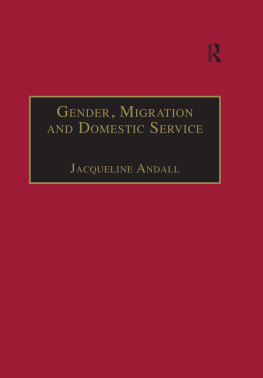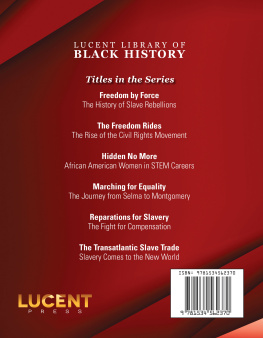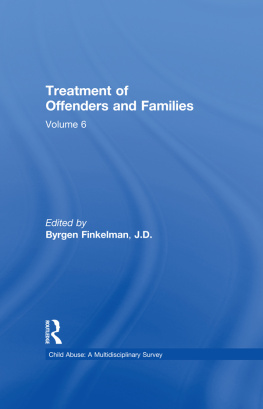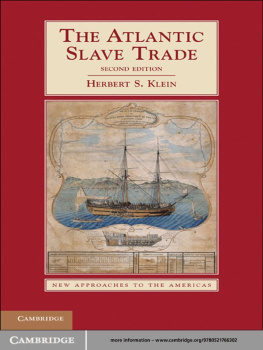First published 1989 by Garland Publishing, Inc.
Published 2019 by Routledge
2 Park Square, Milton Park, Abingdon, Oxon OX14 4RN
52 Vanderbilt Avenue, New York, NY 10017
Routledge is an imprint of the Taylor & Francis Group, an informa business
Copyright 1989 by Paul Finkelman
All rights reserved. No part of this book may be reprinted or reproduced or utilised in any form or by any electronic, mechanical, or other means, now known or hereafter invented, including photocopying and recording, or in any information storage or retrieval system, without permission in writing from the publishers.
Notice:
Product or corporate names may be trademarks or registered trademarks, and are used only for identification and explanation without intent to infringe.
Library of Congress Cataloging-in-Publication Data
Slave trade and migration: domestic and foreign/edited with an introduction by Paul Finkelman.
p. cm.(Articles on American slavery; vol. 2)
ISBN 0824067827 (alk. paper)
1. Slave-tradeUnited StatesHistory. 2. Afro-AmericansPopulationHistory. 3. Slave-TradeSouthern StatesHistory. 4. Afro-AmericansSouthern StatesPopulation. 5. United StatesEmigration and immigration. 6. Migration, InternalSouthern StatesHistory.
I. Finkelman, Paul. II. Series.
E441.S58 1989
380.1440973dc20 8923470
Design by Julie Threlkeld
ISBN 13: 978-0-8240-6782-3 (hbk)
General Introduction
Few subjects in American history have been as compelling as slavery. This should not surprise us. Slavery affected millions of Americans, north and south. Afro-Americans, Euro-Americans, and Native Americans were involved in the system. All antebellum Americans were affected, directly or indirectly, by slavery. Slavery especially affected Americans from 1861 until well after Reconstruction. As Lincoln noted in his famous second inaugural address: The slaves constituted a peculiar and powerful interest. All knew that this interest was somehow the cause of the war.
The goal of this series is to reprint the key articles that have influenced our understanding of slavery. This series includes pioneering articles in the history of slavery, important breakthroughs in research and methodology, and articles that offer major historiographical interpretations. I have attempted to cover all major subtopics of slavery, to offer wide geographic representation and methodological diversity. At the same time, I have resisted the temptation to reprint highly technical articles that will make sense only to specialists in certain fields. For example, I have not included a number of important slavery related articles on economics, law, theology, and literary criticism (to offer just a few examples) because they appeared to be beyond the interest of most generalists.
I have used articles from a wide variety of scholarly journals. I have also used essays and articles in edited volumes, as long as the main focus of those volumes was not slavery, abolition, or black studies. It is my hope that such books are readily available to scholars and students and will show up through card catalogues or on-line catalogue searches. For the same reason I have not reprinted chapters from books about slavery, which are often found in anthologies. With a few exceptions, I have not reprinted articles that later became chapters of books on the same subject. In a few cases I have strayed from this general rule of thumb. I have also generally avoided essay reviews of books, unless the essays go well beyond the common book review or even essay review format. I have also tried to avoid certain famous historiographical controversies that resulted in large numbers of essays being collected and published. With some exceptions, therefore, I have not included the many articles attacking the Elkins thesis or Fogel and Engermans Time on the Cross. Students and scholars interested in these two enormously important scholarly works, and the criticism of them, will find a great deal on both in their card catalogues. Finally, I have also excluded articles from Encyclopedias and dictionaries. These editorial decisions mean that many famous essays and articles will not be found in these volumes. Indeed, a few very important scholars are not represented because all of their work has been in books that are directly on the subject of slavery. Finally, some important articles were left out because we were unable to secure permission from the copyright holders to reprint them in this series.
This project was made easier by the hard work and dedication of Carole Puccino and Leo Balk at Garland Publishing, Inc. A project of this magnitude would not be possible without the help of a number of other scholars, who read lists of proposed articles and discussed the whole problem of slavery with me. I am especially grateful for the help and suggestions of Catherine Clinton, Robert Cottrol, Jill DuPont, Seymour Drescher, Linda Evans, Ronald Formasano, John Hope Franklin, Kermit L. Hall, Robert Hall, Graham Hodges, Michael P. Johnson, Charles Joyner, Alan Kulikoff, Greg Lind, David McBride, Randall Miller, Alfred Moss, James Oakes, Albert J. Raboteau, Judith Schafer, Robert Sikorski, John David Smith, Jean Soderlund, Margaret Washington, William M. Wiecek, Julie Winch, Betty Wood, and Bertram Wyatt-Brown. Two SUNY-Binghamton students, Marci Silverman and Beth Borchers, helped me with much of the bibliographic work on this project. Carol A. Clemente and the inter-library loan staff at SUNY-Binghamton were absolutely wonderful. Without their patience, skills, and resourcefulness, I would have been unable to complete these volumes.





